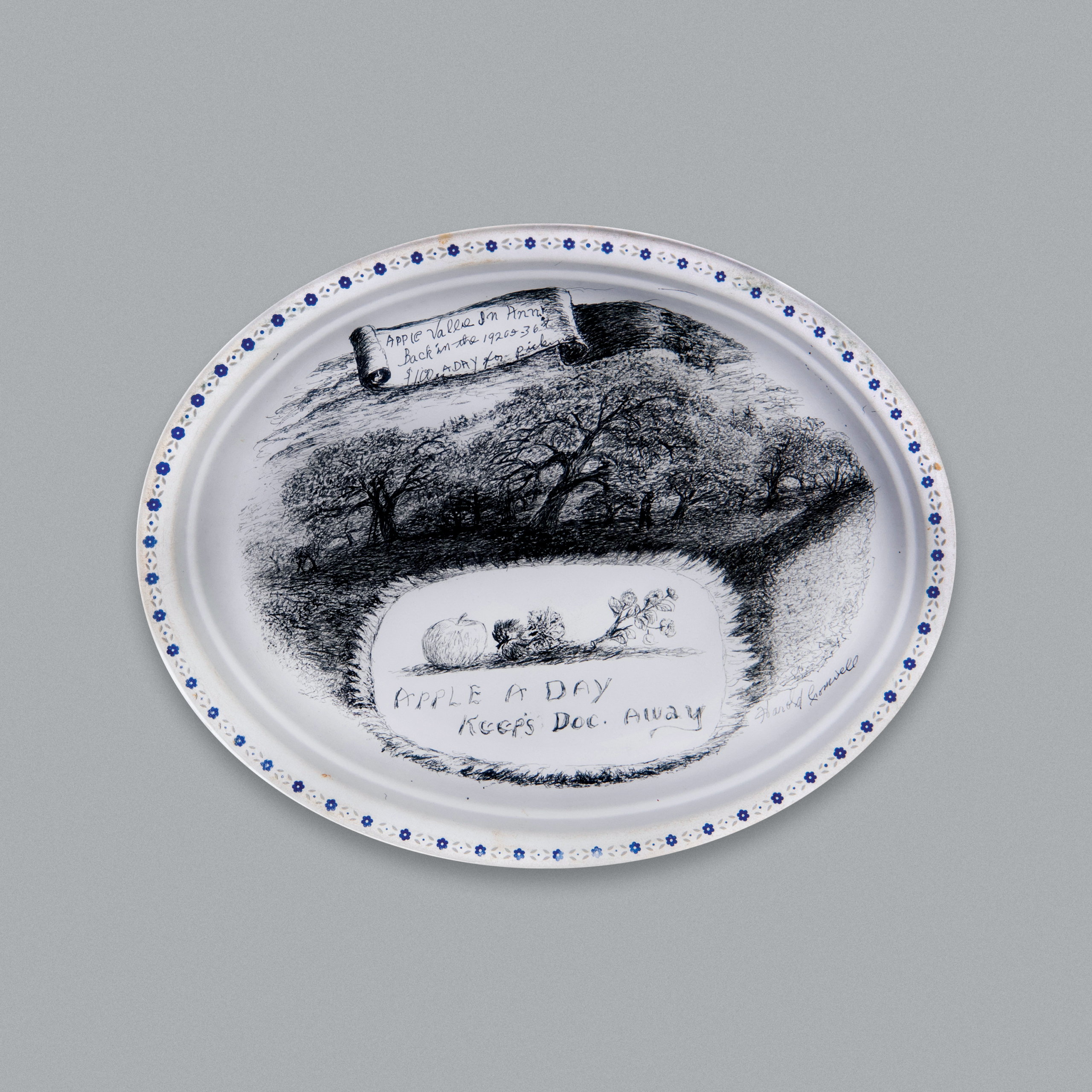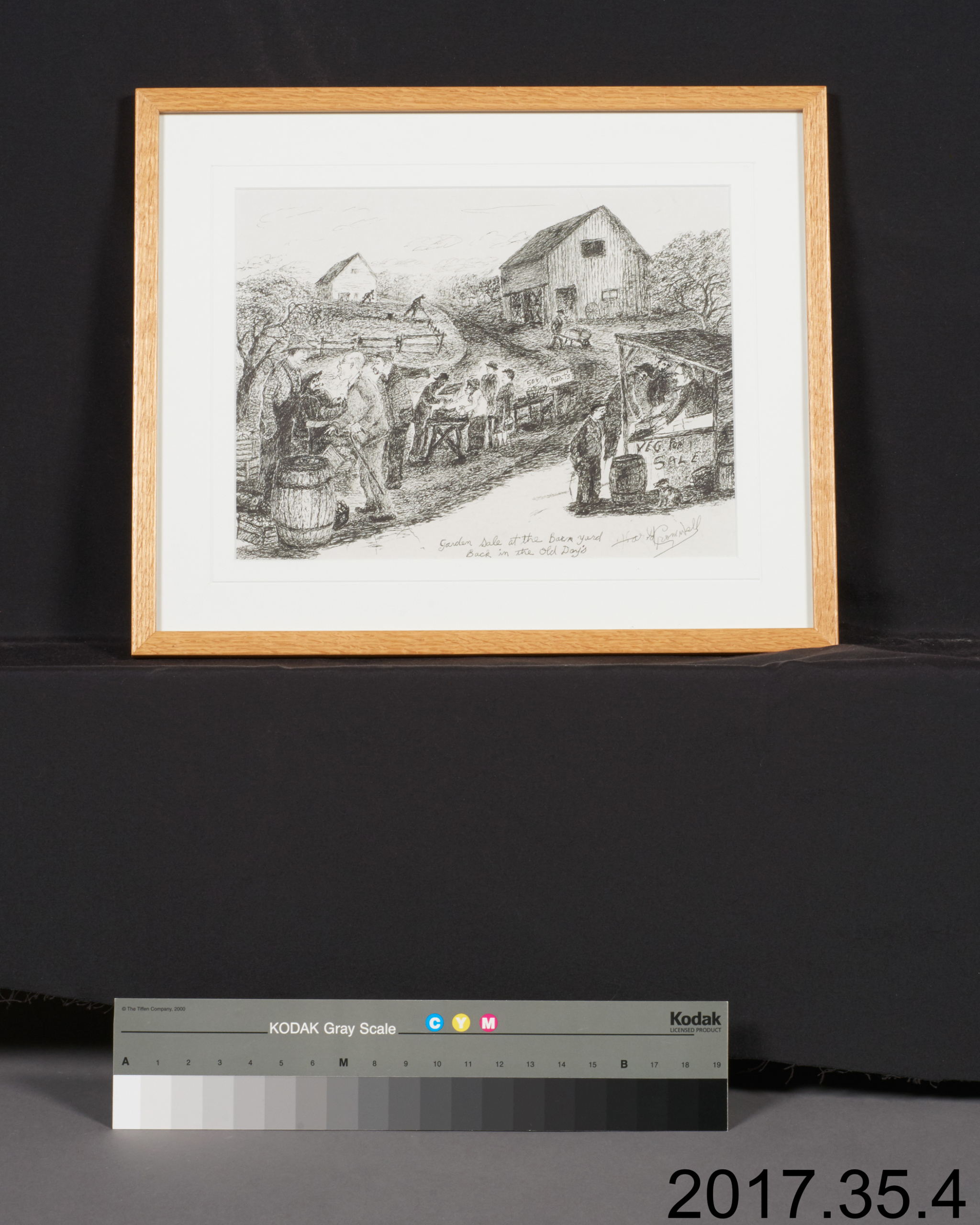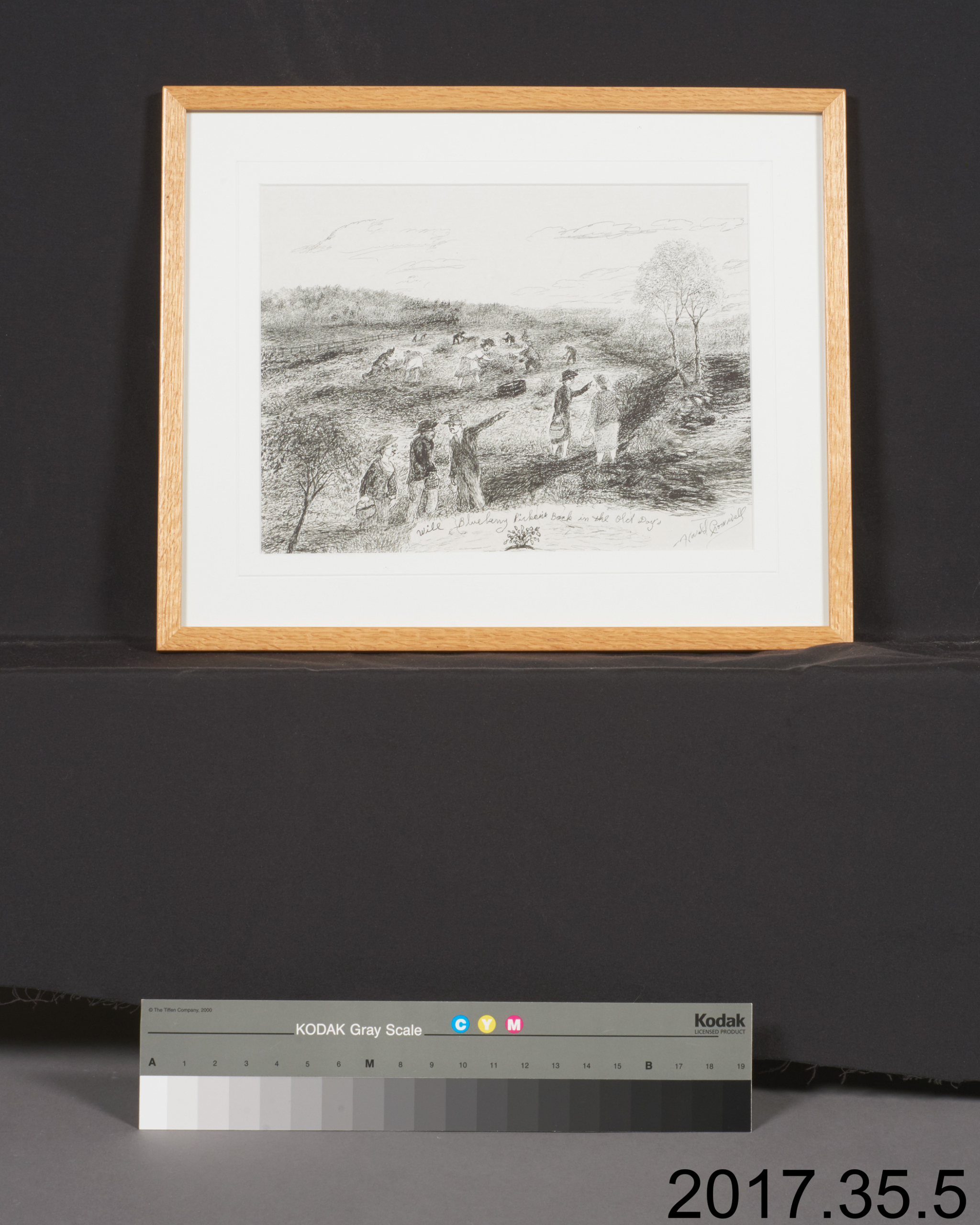Harold Cromwell Drawing
Artifact
Image
Video
Audio
 Activities
Activities
LOOK
Look at An Apple a Day and finish the following sentences:
- I see… [Describe what you see in the drawing.]
- I think… [Explain what you think is happening in the drawing.]
- I wonder… [What questions do you have about the drawing?]
LOOK
Look closely at the three drawings by Harold Cromwell. What are some similarities and differences?
Details
 Materials
Materials - Ink
- Card
- Plastic
- Wood
Historical Context
Choose one of the three levels below to match your needs.
- An Apple a Day is a pen drawing made on a paper plate by African-Nova Scotian artist Harold Cromwell (1919–2008). This piece depicts everyday life in rural Nova Scotia, as drawn from the artist’s memory.
- Cromwell is the most widely recognized African-Nova Scotian folk artist in Canada.
- His art documented life in rural Nova Scotia for more than 50 years. Cromwell used simple materials around him to create his drawings: he drew on plain white paper, paper plates and even the furniture in his home.
Scroll through the media carousel above to see other works by Harold Cromwell.
An Apple a Day is a pen drawing made on a paper plate by African-Nova Scotian artist Harold Cromwell (1919–2008). This piece is one of three drawings from his Good Old Days series, which depicts everyday life in rural Nova Scotia, as drawn from the artist’s memory.
Cromwell is the most widely recognized African-Nova Scotian folk artist in Canada. He began drawing in the 1940s while he was recovering from injuries he suffered in the Second World War.
His art documented life in rural Nova Scotia for more than 50 years. Cromwell used simple materials around him to create his drawings: he drew on plain white paper, paper plates and even the furniture in his home. Cromwell described his art as being grounded in his personal experience of history, during times when he tackled difficult questions about the past, identity and race.
An Apple a Day is a pen drawing made on a paper plate by African-Nova Scotian artist Harold Cromwell (1919–2008). This is one of three drawings from his Good Old Days series, which depicts everyday life in rural Nova Scotia, inspired by the artist’s memories. All three drawings in the series are part of the Canadian Museum of History collection.
Cromwell is the most widely recognized African-Nova Scotian folk artist in Canada. He was a descendant of Joseph and Jane Cromwell, two Black Loyalists and former enslaved Americans who were offered freedom and safe passage to Canada in 1783, following the American Revolutionary War. Cromwell began drawing in the 1940s, while recovering from injuries he suffered in the Second World War. His art attracted particular attention during the political and social movements of the 1960s.
Like An Apple a Day, many of Cromwell’s works are intricate pen drawings depicting daily life, nature, community and labour in his hometown of Weymouth, Nova Scotia. His art documented life in rural Nova Scotia for more than 50 years. Cromwell used simple materials around him to create his drawings: he drew on plain white paper, paper plates and even the furniture in his home.
Cromwell described his art as being grounded in his personal experience of history, during times when he tackled difficult questions about the past, identity and race. As such, his art is both very personal and highly original.
Harold Cromwell’s Good Old Days series has been accredited by the Canadian Cultural Property Export Review Board (CPERB) as being of significant historical and cultural value to Canada.
- An Apple a Day is a pen drawing made on a paper plate by African-Nova Scotian artist Harold Cromwell (1919–2008). This piece depicts everyday life in rural Nova Scotia, as drawn from the artist’s memory.
- Cromwell is the most widely recognized African-Nova Scotian folk artist in Canada.
- His art documented life in rural Nova Scotia for more than 50 years. Cromwell used simple materials around him to create his drawings: he drew on plain white paper, paper plates and even the furniture in his home.
Scroll through the media carousel above to see other works by Harold Cromwell.
An Apple a Day is a pen drawing made on a paper plate by African-Nova Scotian artist Harold Cromwell (1919–2008). This piece is one of three drawings from his Good Old Days series, which depicts everyday life in rural Nova Scotia, as drawn from the artist’s memory.
Cromwell is the most widely recognized African-Nova Scotian folk artist in Canada. He began drawing in the 1940s while he was recovering from injuries he suffered in the Second World War.
His art documented life in rural Nova Scotia for more than 50 years. Cromwell used simple materials around him to create his drawings: he drew on plain white paper, paper plates and even the furniture in his home. Cromwell described his art as being grounded in his personal experience of history, during times when he tackled difficult questions about the past, identity and race.
An Apple a Day is a pen drawing made on a paper plate by African-Nova Scotian artist Harold Cromwell (1919–2008). This is one of three drawings from his Good Old Days series, which depicts everyday life in rural Nova Scotia, inspired by the artist’s memories. All three drawings in the series are part of the Canadian Museum of History collection.
Cromwell is the most widely recognized African-Nova Scotian folk artist in Canada. He was a descendant of Joseph and Jane Cromwell, two Black Loyalists and former enslaved Americans who were offered freedom and safe passage to Canada in 1783, following the American Revolutionary War. Cromwell began drawing in the 1940s, while recovering from injuries he suffered in the Second World War. His art attracted particular attention during the political and social movements of the 1960s.
Like An Apple a Day, many of Cromwell’s works are intricate pen drawings depicting daily life, nature, community and labour in his hometown of Weymouth, Nova Scotia. His art documented life in rural Nova Scotia for more than 50 years. Cromwell used simple materials around him to create his drawings: he drew on plain white paper, paper plates and even the furniture in his home.
Cromwell described his art as being grounded in his personal experience of history, during times when he tackled difficult questions about the past, identity and race. As such, his art is both very personal and highly original.
Harold Cromwell’s Good Old Days series has been accredited by the Canadian Cultural Property Export Review Board (CPERB) as being of significant historical and cultural value to Canada.
Summary
- An Apple a Day is a pen drawing made on a paper plate by African-Nova Scotian artist Harold Cromwell (1919–2008). This piece depicts everyday life in rural Nova Scotia, as drawn from the artist’s memory.
- Cromwell is the most widely recognized African-Nova Scotian folk artist in Canada.
- His art documented life in rural Nova Scotia for more than 50 years. Cromwell used simple materials around him to create his drawings: he drew on plain white paper, paper plates and even the furniture in his home.
Scroll through the media carousel above to see other works by Harold Cromwell.
Essential
An Apple a Day is a pen drawing made on a paper plate by African-Nova Scotian artist Harold Cromwell (1919–2008). This piece is one of three drawings from his Good Old Days series, which depicts everyday life in rural Nova Scotia, as drawn from the artist’s memory.
Cromwell is the most widely recognized African-Nova Scotian folk artist in Canada. He began drawing in the 1940s while he was recovering from injuries he suffered in the Second World War.
His art documented life in rural Nova Scotia for more than 50 years. Cromwell used simple materials around him to create his drawings: he drew on plain white paper, paper plates and even the furniture in his home. Cromwell described his art as being grounded in his personal experience of history, during times when he tackled difficult questions about the past, identity and race.
In-Depth
An Apple a Day is a pen drawing made on a paper plate by African-Nova Scotian artist Harold Cromwell (1919–2008). This is one of three drawings from his Good Old Days series, which depicts everyday life in rural Nova Scotia, inspired by the artist’s memories. All three drawings in the series are part of the Canadian Museum of History collection.
Cromwell is the most widely recognized African-Nova Scotian folk artist in Canada. He was a descendant of Joseph and Jane Cromwell, two Black Loyalists and former enslaved Americans who were offered freedom and safe passage to Canada in 1783, following the American Revolutionary War. Cromwell began drawing in the 1940s, while recovering from injuries he suffered in the Second World War. His art attracted particular attention during the political and social movements of the 1960s.
Like An Apple a Day, many of Cromwell’s works are intricate pen drawings depicting daily life, nature, community and labour in his hometown of Weymouth, Nova Scotia. His art documented life in rural Nova Scotia for more than 50 years. Cromwell used simple materials around him to create his drawings: he drew on plain white paper, paper plates and even the furniture in his home.
Cromwell described his art as being grounded in his personal experience of history, during times when he tackled difficult questions about the past, identity and race. As such, his art is both very personal and highly original.
Harold Cromwell’s Good Old Days series has been accredited by the Canadian Cultural Property Export Review Board (CPERB) as being of significant historical and cultural value to Canada.



